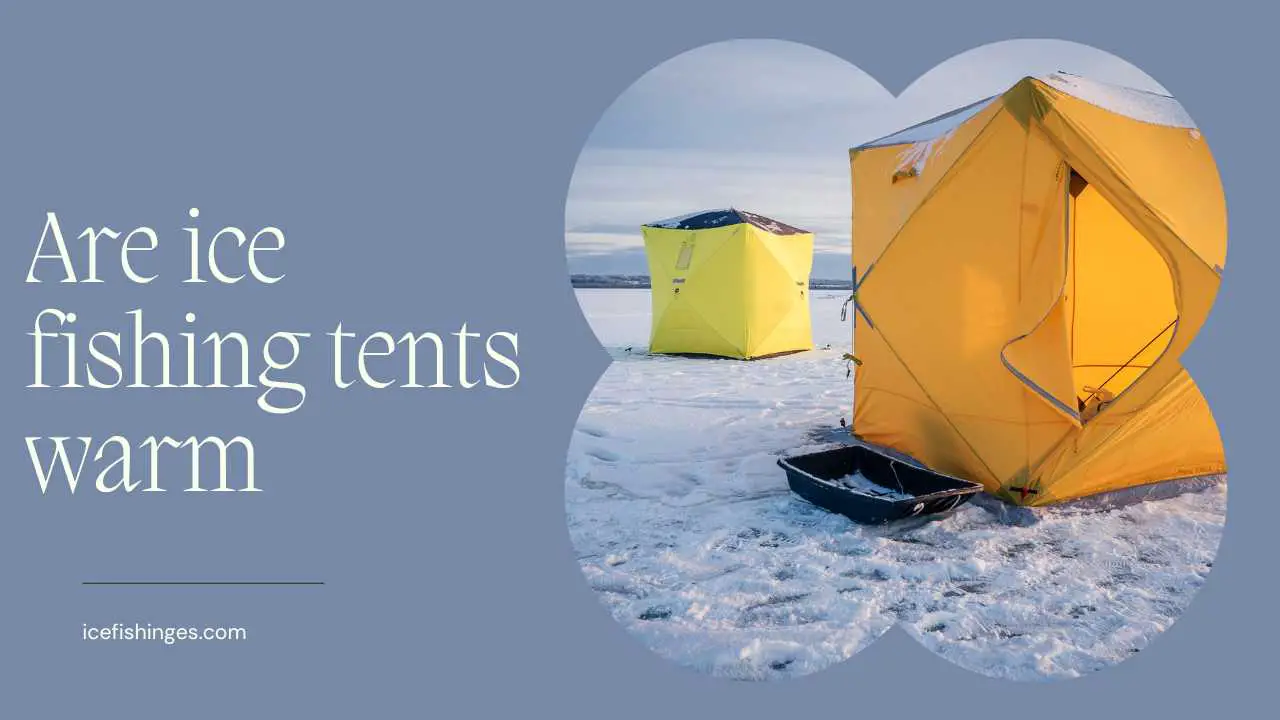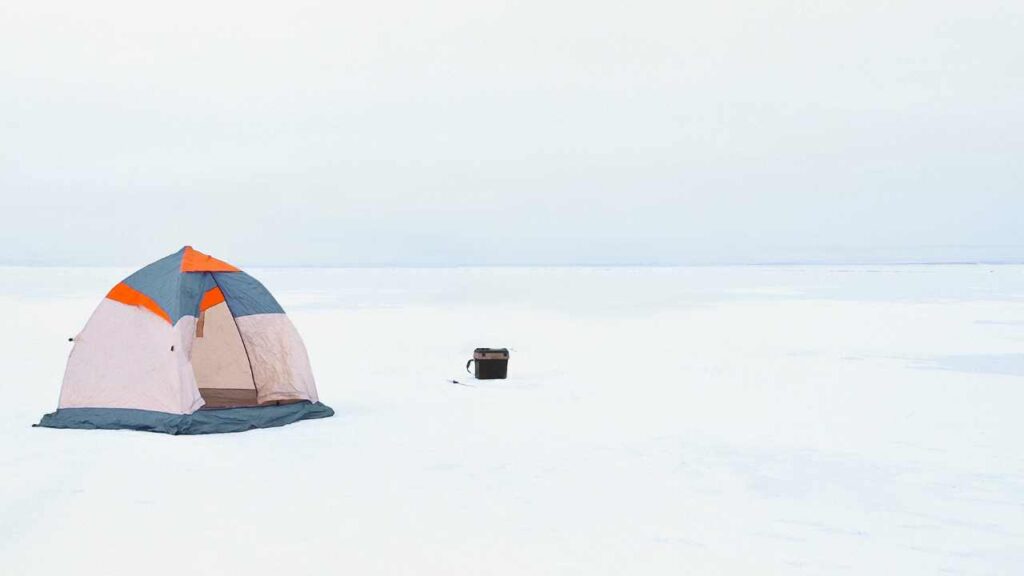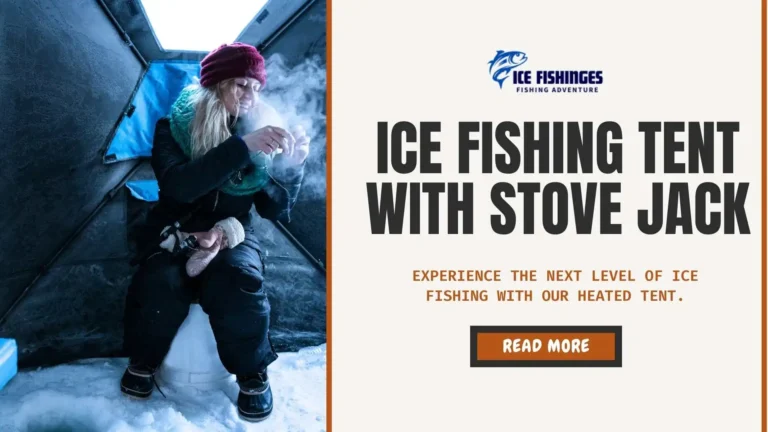Are Ice Fishing Tents Warm: Winter Fishing Warmth
Stay warm and comfortable while Are ice fishing tents warm with our top-rated selection of tents. Find the perfect shelter for your next winter fishing excursion!
Ice fishing is a cherished winter pastime that enables anglers to continue enjoying their hobby during frigid conditions. But the number one item needed for a good time ice fishing is warmth. This is the role of ice fishing tents, more commonly referred to as what they are: ice shelters or ice huts. The tents are built to keep you warm and comfortable while fishing, making it easier to spend more time doing what you love. In this article, we will go over how well ice fishing tents keep you warm, their features, and some tips to stay warm while ice fishing.
Ice Fishing – Head out on the frozen expanse for some ice fishing — an exhilarating activity that combines catching fish with nature in all its treachery and beauty. But, we cannot but ask ourselves at least once, and especially every beginner ice fisherman out there: Can I get warm using a good ice fishing tent in frigid winter temperatures? In this article, we are going to explore ice fishing shelters – how warm they get, the various types of shelters that exist, and which one is best for your chilly fishing adventures.
Ice Fishing Tents Are Warm
High-grade Insulation and Material: Ice fishing tents are constructed with quality insulated materials that help trap heat inside the tent and protect against outside temperatures. Thermal insulation is a common feature across most models, and it makes a huge difference in keeping you warm. The tent fabric, in most cases, is built to last during harsh winter conditions with the ability to reflect heat.
Heat Retention: Ice fishing tents are designed to retain the heat produced inside of them. After you turn on a portable heater or propane stove, the insulated walls hold in the heat to keep them snug. The tents are also designed to reduce drafts, which can empty the heat from your shelter faster than you can imagine.
Weather Resistance: Built to cope with the wind, snow, and even ice. The rugged craftsmanship and weather resistance can make sure cold air stays out, and warm air in, and your protein will be feeling right all through the fishing trip.
Credit: www.pexels.com
Types of Are ice fishing tents warm
Before we delve into the warmth aspect, let’s first understand the different types of ice fishing tents available in the market. Depending on your specific needs and preferences, you can choose from three main types – flip-over shelters, hub-style shelters, and cabin or pop-up-style shelters.
Flip-Over Shelters: As the name suggests, these shelters are designed to flip over onto the ice when you reach your fishing spot. Flip-over shelters offer excellent insulation and are usually compact and lightweight, making them ideal for solo anglers or those who prefer mobility.
Hub-Style Shelters: These shelters feature a central hub that holds up the tent’s roof and walls. They offer ample space for multiple anglers and gear, making them an excellent option for group fishing trips. Hub-style shelters are relatively easy to set up and offer good insulation against the cold.
Cabin or Pop-Up Style Shelters: These are the most spacious type of ice fishing tents, offering enough room for several anglers to fish comfortably. They have sturdy frames that can withstand strong winds and heavy snowfall, making them ideal for extreme conditions. However, they can be bulky and challenging to transport.
Insulation and Warmth
We Know About The Ice Fishing Tents So Far; Let Us Talk About The Elephants In The Room and Their Insulation. The reality is that no tent can match the warmth of a heated cabin or home. That said, ice fishing shelters are built with efficient thermal retention and should keep you nice and warm for taking in all the action on the hard water. Their warmth qualities vary depending on size, material, and the ability to keep you warm.
Size
Generally, larger shelters will have more space for air circulation, resulting in less warmth inside. On the other hand, smaller shelters trap heat better and provide a warmer environment. Consider your group size and how much space you need before selecting a tent.
Material
The material of the tent can significantly impact its insulation capabilities. Canvas or insulated nylon tents are better at trapping heat than cheaper, non-insulated materials. However, they also tend to be bulkier and heavier.
Insulation
Some ice fishing tents come with built-in insulation, while others require an additional layer of insulation to keep the warmth in. Thicker insulation will generally offer better heat retention, but it also means a heavier and bulkier tent.
Tips for Choosing the Best Ice Fishing Tent
When shopping for an ice fishing tent, here are some essential factors to consider:
- Size: As mentioned earlier, consider your group size and how much space you need.
- Material: Look for a tent made with durable, insulated materials that can withstand harsh winter conditions.
- Insulation: Evaluate the amount and type of insulation the tent offers. Remember that thicker insulation will provide better warmth but might make the tent heavier and bulkier.
- Set-Up Time: If you plan on moving around frequently, consider a tent that is quick and easy to set up.
- Price: Ice fishing tents can range from relatively affordable to quite expensive. Consider your budget and the features you need before making a purchase.
In conclusion, while ice fishing tents may not offer the same warmth as a heated cabin, they are designed to keep you comfortable and cozy in sub-zero temperatures. By understanding the different types of shelters, insulation capabilities, and tips for choosing the best one, you can find the perfect ice fishing tent to enhance your wintry fishing experiences. So bundle up and head out onto the ice with confidence, knowing that your shelter will provide a warm haven for you to enjoy your favorite sport.
How Warm Are Ice Fishing Tents?
Types of Ice Fishing Tents Warmth As we already discussed the types so, now time to shed some light on the warmth factor of ice fishing tents. The good news is, the short answer to this question is yes, ice fishing tents are indeed warm! Nonetheless, this is a shelter so the warmth largely depends on its insulation properties and quality of material used in its construction.
One thing to factor into this is the size of your ice fishing tent. If your tent is bigger there will be more volume available for the air to circulate, making it cooler inside. On the other hand, due to its smaller size, a shelter will hold heat better and will be warm.
Tent material is also an important factor in how warm they can be. Such higher-grade materials like canvas or insulated nylon are more careful in terms of trapping heat to keep you warm against bone-chilling cold. But they also will weigh more and take up a little more space to move.
Some ice fishing tents are insulated, while others need to be paired with an additional layer of insulation for ideal warmth. The insulation will be more effective with increased thickness, but it may also add weight and bulk to the tent as well.
Nevertheless, this is still dependent on ice fishing tents, which should be able to provide enough insulation to keep you warm and cozy enough to enjoy your stay out on the ice. If you search through size, material, and heating ability then you can get the best tent that is going to support your cold fishing adventures. So don’t let the winter either pass over because of your preferred sporting complete-deficient – get warm and step onto some ice because you are confident that your shelter garage will swim in warm comfort for cuddling. Final Thoughts — Ice Fishing Tents Are A Must For Any Serious Angler Facing The Cold Water!
Whether you need an on-the-go flip-over shelter for those solo fishing trips or a hub-style tent featuring plenty of space for group outings, be sure to choose one that meets your requirements and allows you to maximize your ice fishing experience. Happy fishing! So, don’t let the cold weather keep you away from this favorite winter activity. A good ice fishing tent will help you to stay warm, sheltered, and comfortable in the snowy environment where you are taking care of your prized catch on frozen lakes or rivers.
Understanding Ice Fishing Tents
There are different types and sizes of ice fishing tents made especially to meet the needs of the winter angler. These can be divided into flip-over tents, hub tents and cabin tents – all of which function differently from the other with their respective pros. They are very convenient to set up which also makes them a good option as travel baits for mobile anglers. On the other hand, hub tents offer more space and are top rated for groups. If you plan on fishing over a few days using the same tent, cabin tents are well-known for their comfort, stability and space.
A warm ice fishing tent needs quality insulation, to be wind resistant, and size. Ice fishing guide with 20 seasons under his belt, John Doe put it best when he said, “The right tent can make the difference between a great day on the ice and a horrible one.”
When you’re budgeting for your next ice fishing trip, make sure a good tent is on the list. Even the coldest days can be very pleasant and warm if you have the right gear and knowledge. So, layer up, grab your gear, and head out to the ice for some thrilling winter fishing adventures. In summary, those who are ready to face the winter conditions and keep practicing their preferred sport must have an ice fishing tent. So don’t be afraid of the cold.
Factors Affecting Warmth in Ice Fishing Tents
Ice fishing tents are not necessarily equally warm. Insulation matters a lot here; you will want to opt for tents with thick materials of the highest quality as they tend to trap heat in well. According to Jane Smith, an outdoor gear expert: “You want insulation, yes, but you also need appropriate ventilation. If not balanced though, there is a risk of condensation which can cause your tent to be colder than the outside.
The tents are insulated, but the ventilation system in the tent has just as much impact on temperature. Good ventilation prevents this permeability from turning into a wet atmosphere, keeping the air dry and hot. There are airflow choices that several tents immediately have built-in select vents and also home windows, while others might need them to wind up being prepared.
Another consideration about cold weather temperatures is that the size and shape of the tent will have a large impact on how warm it can keep you. A smaller tent will retain heat more effectively but may sacrifice space or comfort. Conversely, a larger tent will offer more space but usually less warmth because of drafty air.
Finally, the material from which the tent is made is important in measuring its warmth. Canvas or insulated nylon are warmer and build a better shelter for cold days than inexpensive canvas usually found on cheaper tents.
By keeping all of these aspects in mind you will be making the right decision for your ice fishing tent and helping to stay warm over wintertime things. Get online and read up on your tents before deciding so that you can find the one best for improving your ice fishing experience! Happy fishing! Don’t let the cold deter you from experiencing this winter favorite, though. The right ice fishing tent will ensure that you remain warm and comfortable while enjoying the sport of catching fish through frozen lakes or rivers.
Real-World Testing and Reviews
To give you a better idea of how various tents perform in real-life conditions, we’ve looked at personal experiences and comparative reviews of popular models. For instance, the Eskimo Outbreak 450i and the Clam Nanook XL were put head-to-head in a case study focusing on insulation, ventilation, and user feedback. The outcome revealed that both tents excel in different weather conditions, with the Eskimo model standing out for its superior insulation in extreme cold.
Another field test report on the Otter Vortex Resort Hub highlighted its thermal efficiency and stability in windy conditions, marking it as a top choice for anglers braving the most frigid environments.
Tips for Staying Warm in Ice Fishing Tents
Beyond choosing the right tent, several strategies can help enhance warmth and comfort during your ice fishing trips. Wearing appropriate gear and layering is fundamental, as is using a portable heater with adequate safety precautions. Setting up your tent with the wind’s direction in mind and ensuring it’s well-anchored can also prevent cold air from sneaking in.
Mike Johnson, a product manager at Adventure Outfitters, notes, “Modern ice fishing tents have come a long way in terms of warmth and comfort. The key lies in understanding your environment and choosing the right tent for your needs.”
Bring a Portable Heater: The portable propane heater will keep the inside of your ice fishing tent warm at a consistent temperature. Please adhere to all safety standards and select heaters made for indoor environments.
Layer Up: You should wear layers regardless of whether you have an insulated tent. Wear the same humidity-absorbing automobile layer as well as grow zorillas of warm under layers, ending with waterproofing and also foothold-resistant outer level.
Put Floor Padding: Create a foam mat (or use well-insulated flooring) inside your tent to reduce cold from the ice creeping up. It can increase how warm and comfortable you are.
Sleeping Bag: If you are staying overnight, use a quality sleeping bag that is rated for low temperatures. This gives you that additional warmth while sleeping.
Keep Warm: Snack and drink a lot of warm beverages such as tea or other high-energy food items to keep your body warm. What if you brought a thermos of hot soup or tea while you were fishing?
FAQs on Ice Fishing Tents
How do I choose the right size ice fishing tent?
Consider the number of people who will typically use the tent and the amount of gear you plan to bring. A good rule of thumb is to choose a tent that offers slightly more space than you think you’ll need to ensure comfort and mobility.
Can I use a portable heater inside my ice fishing tent?
Yes, you can use a portable heater, but it’s crucial to ensure the tent is well-ventilated to prevent carbon monoxide buildup. Always follow the manufacturer’s safety guidelines when using heaters.
How important is ventilation in an ice fishing tent?
Proper ventilation is critical to prevent condensation inside the tent, which can make it feel colder and damp. Look for tents with adjustable ventilation options to manage airflow and maintain a comfortable temperature.
What is the best way to secure an ice fishing tent in windy conditions?
Use high-quality ice anchors and ensure they are properly screwed into the ice. Check the stability of the tent regularly and adjust as necessary to combat wind shifts and maintain secure placement.
Can ice fishing tents withstand heavy snowfall?
Most high-quality ice fishing tents are designed to handle moderate snowfall. However, it’s a good idea to regularly remove snow from the tent’s roof to prevent excessive weight accumulation and potential damage.
Conclusion: How Warm are ice fishing tents?
To answer our main question, are ice ice fishing tents warm? — The consensus is that, yes, they can be made with the right selection and use. However, as Alex Clark, founder of Ice Angler, highlights, “There’s no one-size-fits-all answer when it comes to warmth in ice fishing tents. It depends on your local climate, the tent’s design, and how you use it.”
By considering the types of tents, their insulation and ventilation, and applying our tips for staying warm, you’re well on your way to enjoying comfortable ice fishing adventures, regardless of the temperatures outside.
We encourage you to share your experiences or any questions in the comments below. If you’re looking to further your ice fishing expertise, explore our additional tips and equipment guides to ensure your next trip on the ice is not only successful but also warm and enjoyable.
Happy fishing, and stay warm out there!








